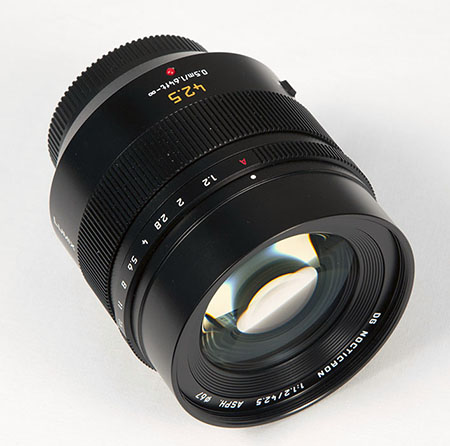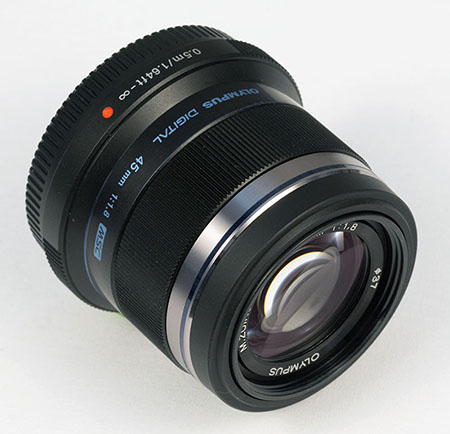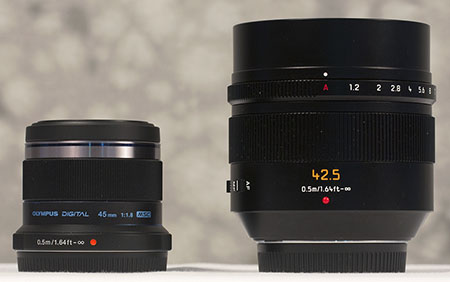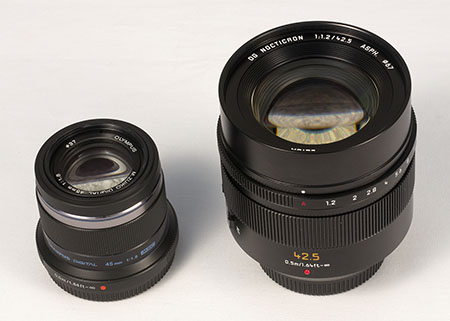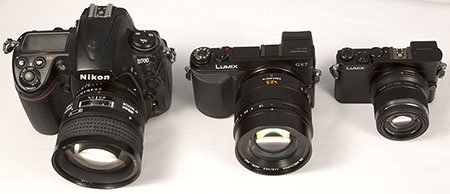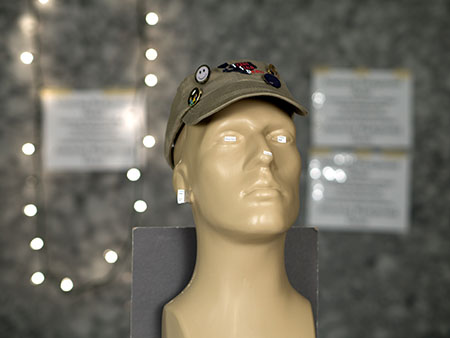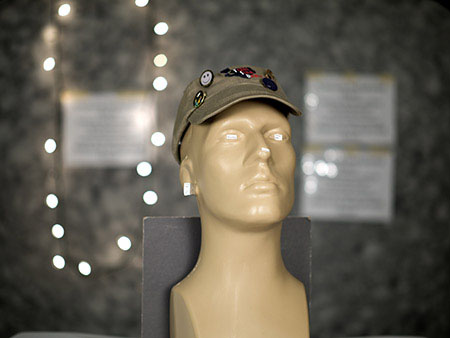Panasonic Lumix G Leica DG Nocticron 42.5mm f/1.2
The search for micro four thirds bokeh
This site contains a few tests for bokeh, MTF50 and light dropoff that I ran on the Panasonic Lumix G Leica DG Nocticron 42.5mm f/1.2 lens compared to the Olympus 45mm f/1.8 lens with a few portrait application examples. I also compared bokeh from the two micro four thirds lenses with that produced by two 85mm lenses in 35mm format.
For portrait photography in 35mm format, 85mm, wide aperture lenses (28.5 degree angle of view) offer the promise of excellent sharpness and background blurring (bokeh) function that creates the effect of the subject popping out of an attractively blurred background. For me, a dilemma with 85mm lenses in 35mm format portrait application is having to stop the aperture down enough with a short working distance to get both eyes in the focal plane and still have diffuse background blurring. I have owned several reasonably good 85mm lenses (Canon EF 85mm f/1.2L II, Nikkor 85mm f/1.4 D AF, Zeiss Planar T* 85mm f/1.4) that never resolved the dilemma of adequate depth of focus and maximal bokeh when working in close with a single portrait subject. Generally, I have used 85mm portrait lenses with full frame cameras in the f/2.8 aperture range (f/2 to f/4) for portrait application.
Micro four thirds format offers
greater depth of focus at wide apertures than 35mm format lenses and can achieve moderate background blurring. The backgroud blurring is rarely on the same scale as that achieved with 35mm format lenses. Many reviews I read and images I saw indicated that the Panasonic Lumix G Leica DG Nocticron 42.5mm f/1.2 lens (28.5 degree angle of view) should offer a substantial improvement in bokeh while also producing sharply focused images of facial features. So I rented the 42.5mm Nocticron and ran tests with it against my Olympus 45mm f/1.8 as well as a few Nikkor 85mm lenses in 35mm format.
Micro Four Thirds Lenses Tested in the Review with a Panasonic GX7 Camera:
Nikkor 35mm Lenses Tested in the Review with a Nikon D700 Camera:
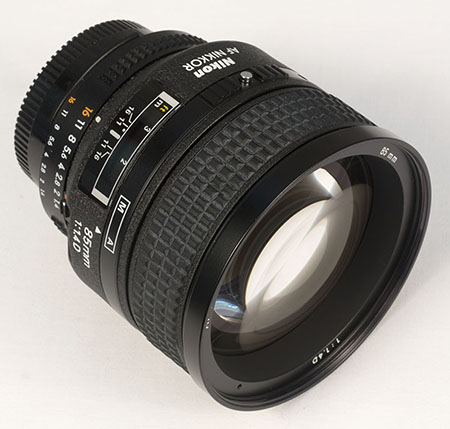 Nikkor 85mm f/1.4 D AF
Nikkor 85mm f/1.4 D AF
|
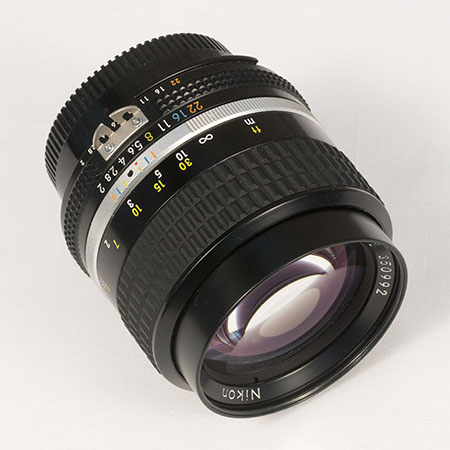 Nikkor 85mm f/2 AIS |
| Why test 35mm Nikkor lenses? They provide a familiar benchmark for bokeh produced by quality full frame 35mm cameras. The Nikkor 85 1.4D AF is a 1990's design for film cameras that gives good quality bokeh at wide apertures representative of other quality 35mm format lenses at this focal length. |
The Nikkor 85mm f/2 AIS is a 1981 update of an optics design from the 1970's when Nikkor made a broad series of wide angle to telephoto lenses that accepted 52mm filters. It has a 7 blade iris diaphram with straight blades that make interesting patterns in bokeh tests. Although designed for film cameras, I own this for astrophotography use: Bernard's Loop in hydrogen alpha. |
MTF50 and Light Dropoff Results
MTF50 performance was determined using Imatest Master v. 3.7 as described using a SFRplus Chart. A 13 region, center-weighted MTF50 value is posted below as well as center, midzonal, and corners lens performance. Regions of analysis on the SFRplus chart are described HERE. Light dropoff was also calculated using Imatest as described. Click on the images to see larger image files.
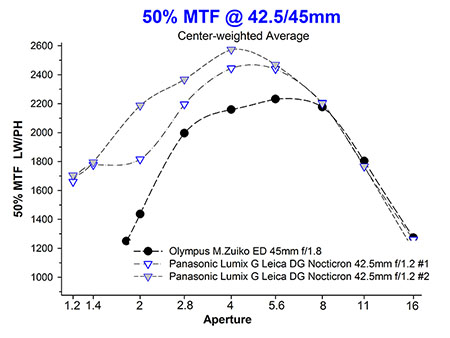 Center-Weighted Average MTF50 for Micro Four Thirds Lenses #1 = Rental lens #2 = Puchased Used Lens MTF50 data on Nikkor lenses with D700 (early generation full frame sensor) Test of Nikkor 85mm f/1.4 with OM-D E-M5 shows better camera performance (Here). |
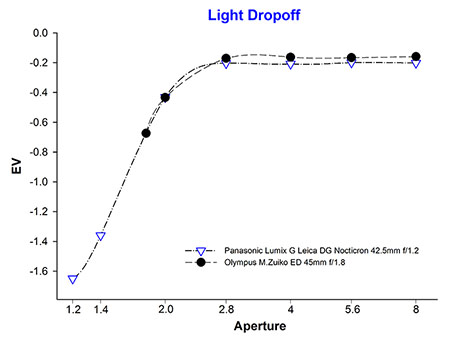 Light Dropoff (Vignetting) Here's an image showing vignetting from the Panasonic Lumix 42.5mm lens at f/1.2 Although there is significant vignetting at wide apertures, this can create attractive features in a portrait lens. If not desired, it can be corrected by shooting in raw and processing for even illumination. |
Test Photographs at 45mm with Mannequin Head Target with Bokeh Test Background
A number of lens design characteristics influence the quality of out of focus blur (online references: Merklinger , van Walree and Atkins) including aperture (both f/stop setting and maximal lens opening size), aperture iris shape, and degree of spherical aberration correction. In this test for each lens, the aperture was set to bring both eyes into focus, and the qualities of the background were evaluated.
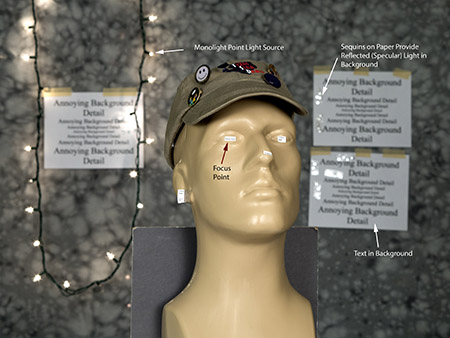 Olympus M.Zuiko ED 45mm f/1.8 @ f/8 Mannequin Head Target with Bokeh Test Background The mannequin is 6 feet (183 centimeters ) in front of the background. The camera is 5 feet (152 centimeters) from the mannequin head. The focus point is the mannequin right eye. Click on image for target detail. The test determines whether both eyes are in focus as well as other head detail. The test also determines whether even blur discs are created from the specular light in the background and whether the text is attractively blurred. The diaphragm aperture pattern shows in the image of the out of focus point light source. |
|
|
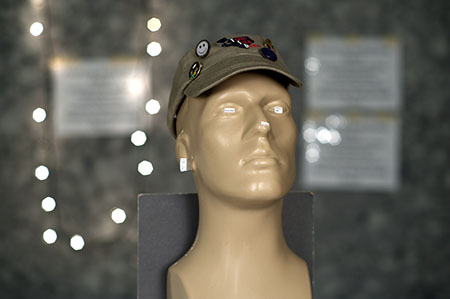 Nikkor 85mm f/2 AIS @ f/2.8 Both eyes are in focus. This old lens produces excellent blurring of the background. However, the 7 straight diaphragm blades creates heptagonal images in both the out of focus point source and specular light. 28.5 degree of angle view. For comparison: f/4 |
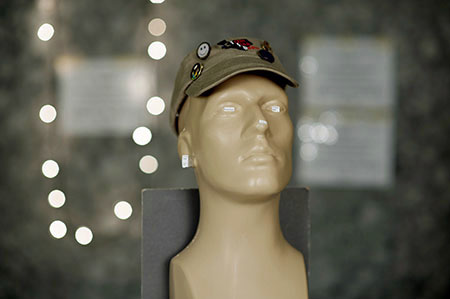 Nikkor 85mm f/1.4 D AF @ f/2 Both eyes are in focus, and background is blurred to a greater degree to the image from the 42.5mm lens at f/1.4. 28.5 degree angle of view. There is mild vignetting. This lens is sharp enough to shoot at f/2 and have eyes in focus. The nose tip is out of focus. For comparison: f/1.4; f/2.8; f/4 |
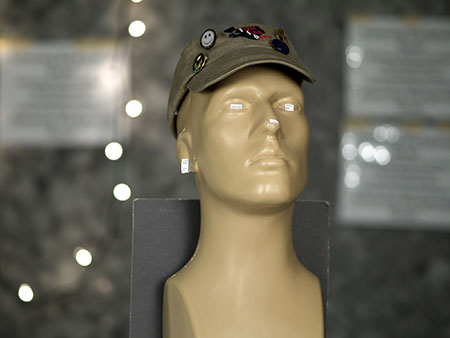 Olympus M. Zuiko 75mm f/1.8 lens at f/1.8 The face is in focus and background evenly blurred with this lens wide open. It has a narrower 16 degree angle of view. Working distance from mannequin: 8 feet. The Olympus 75mm f/1.8 lens will achieve many of the objectives of the Panasonic 42.5 f/1.2 lens as far as sharpness and bokeh if you have the working space and don't mind the narrower field of view. |
My First Photographs with the Panasonic Lumix G Leica Nocticron 42.5mm f/1.2 - Bountiful Bokeh
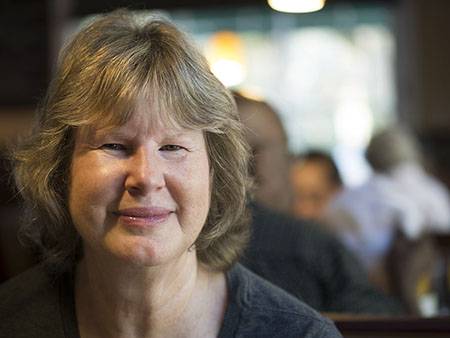 Breakfast Bokeh at f/1.4 Full frame photo of my wife at our local bistro. This photo was taken at f/1.4 across a 30 inch table. In the next booth approximately 5 inches behind my wife, the backround is softly blurred. |
 Cropped image of Limpkin at f/1.6 This is a cropped image taken of a habituated Limpkin who tolerated my getting very close. Palm trees in the background are nicely blurred. |
| Snapshots for Section Web Photos Before my rental period with the lens was over, I took a quick series of snap shots of colleagues in my section for our web pages. Most of the images were shot at f/1.4 in office settings with a few exceptions. The Panasonic Lumix G Leica DG Nocticron 42.5mm f/1.2 lens blotted out cluttered backgrounds at office desks and in otherwise unattractive work areas and isolated the subject in most cases to very good effect. See photo series HERE. |
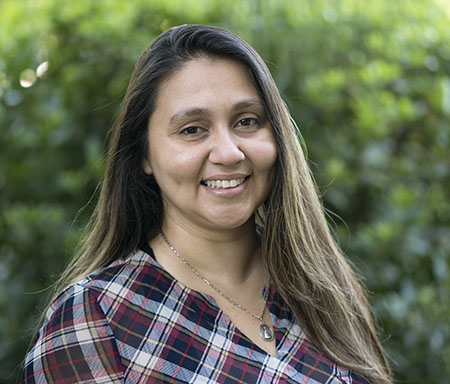 Cropped f/1.4 Snapshot with Pleasing Bokeh |
Summary Points for Panasonic Lumix G Leica DG Nocticron 42.5mm f/1.2
- MTF50 performance is excellent and even better than that for the very sharp Olympus 45mm f/1.8 lens. MTF50 performance wide open at f/1.2 or 1.4 is very good and more than sufficient for portrait photography.
- Out of focus blurring (bokeh) is excellent and allows for attractive separation of subject from softly blurred background even in very cluttered spaces where you would not normally be able to control the background.
- I found lens performance of the Panasonic Lumix G Leica DG Nocticron 42.5mm f/1.2 at f/1.4 aperture to be roughly equivalent as far as depth of focus and background blurring to the Nikkor 85mm f/1.4 at 2.8 aperture on a full frame 35mm format camera.
- Although the magnitude of background blurring with the Panasonic 42.5mm f/1.2 lens is not as pronounced as can be achieved with an f/1.4 85mm lens in 35mm format, the combination of adequate depth of focus for facial features and very good bokeh make the Panasonic lens a very powerful portrait lens.
Conclusion for the Panasonic Lumix G Leica DG Nocticron 42.5mm f/1.2
This is an outstanding portrait lens for micro four thirds cameras. The sharpness (MTF50) of the lens at f/1.2 or f/1.4 is outstanding, and the background blurring (bokeh) performance is exceptionally pleasing for portrait application. I rented the lens for photographic tests thinking that I might find the combination of the Olympus 45mm and 75mm f/1.8 lenses sufficient for my portrait needs. It was clear to me half way through the tests and after taking a few photographs of people that this is a very special lens that achieves a performance level that fits in very well with the type of portrait photography I do. Your needs and experience may differ. This lens is expensive, but I consider it to be no more expensive than other high performance lenses. For use in portrait photography, it is worth every penny. That having been stated, the features about micro four thirds cameras that brought me into the system are their small size and excellent performance. The Nocticron is not small. So, I'll be keeping my Olympus 45mm f/1.8 to put on my GM5 for more stealthy candid portrait applications.
posted 11 October, 2016
© 2016, William L. Castleman
